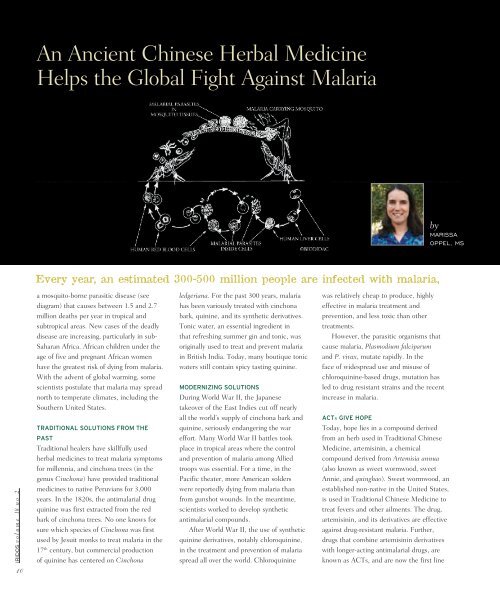Botanical Expedition! - Botanical Research Institute of Texas
Botanical Expedition! - Botanical Research Institute of Texas
Botanical Expedition! - Botanical Research Institute of Texas
You also want an ePaper? Increase the reach of your titles
YUMPU automatically turns print PDFs into web optimized ePapers that Google loves.
iridos volume 18 no 2<br />
10<br />
An Ancient Chinese Herbal Medicine<br />
Helps the Global Fight Against Malaria<br />
Every year, an estimated 300-500 million people are infected with malaria,<br />
a mosquito-borne parasitic disease (see<br />
diagram) that causes between 1.5 and 2.7<br />
million deaths per year in tropical and<br />
subtropical areas. New cases <strong>of</strong> the deadly<br />
disease are increasing, particularly in sub-<br />
Saharan Africa. African children under the<br />
age <strong>of</strong> five and pregnant African women<br />
have the greatest risk <strong>of</strong> dying from malaria.<br />
With the advent <strong>of</strong> global warming, some<br />
scientists postulate that malaria may spread<br />
north to temperate climates, including the<br />
Southern United States.<br />
tRAditionAl solutions fRoM thE<br />
PAst<br />
Traditional healers have skillfully used<br />
herbal medicines to treat malaria symptoms<br />
for millennia, and cinchona trees (in the<br />
genus Cinchona) have provided traditional<br />
medicines to native Peruvians for 3,000<br />
years. In the 1820s, the antimalarial drug<br />
quinine was first extracted from the red<br />
bark <strong>of</strong> cinchona trees. No one knows for<br />
sure which species <strong>of</strong> Cinchona was first<br />
used by Jesuit monks to treat malaria in the<br />
17th century, but commercial production<br />
<strong>of</strong> quinine has centered on Cinchona<br />
ledgeriana. For the past 300 years, malaria<br />
has been variously treated with cinchona<br />
bark, quinine, and its synthetic derivatives.<br />
Tonic water, an essential ingredient in<br />
that refreshing summer gin and tonic, was<br />
originally used to treat and prevent malaria<br />
in British India. Today, many boutique tonic<br />
waters still contain spicy tasting quinine.<br />
ModERnizing solutions<br />
During World War II, the Japanese<br />
takeover <strong>of</strong> the East Indies cut <strong>of</strong>f nearly<br />
all the world’s supply <strong>of</strong> cinchona bark and<br />
quinine, seriously endangering the war<br />
effort. Many World War II battles took<br />
place in tropical areas where the control<br />
and prevention <strong>of</strong> malaria among Allied<br />
troops was essential. For a time, in the<br />
Pacific theater, more American solders<br />
were reportedly dying from malaria than<br />
from gunshot wounds. In the meantime,<br />
scientists worked to develop synthetic<br />
antimalarial compounds.<br />
After World War II, the use <strong>of</strong> synthetic<br />
quinine derivatives, notably chloroquinine,<br />
in the treatment and prevention <strong>of</strong> malaria<br />
spread all over the world. Chloroquinine<br />
was relatively cheap to produce, highly<br />
effective in malaria treatment and<br />
prevention, and less toxic than other<br />
treatments.<br />
However, the parasitic organisms that<br />
cause malaria, Plasmodium falciparum<br />
and P. vivax, mutate rapidly. In the<br />
face <strong>of</strong> widespread use and misuse <strong>of</strong><br />
chloroquinine-based drugs, mutation has<br />
led to drug resistant strains and the recent<br />
increase in malaria.<br />
by<br />
marissa<br />
oppel, ms<br />
Acts givE hoPE<br />
Today, hope lies in a compound derived<br />
from an herb used in Traditional Chinese<br />
Medicine, artemisinin, a chemical<br />
compound derived from Artemisia annua<br />
(also known as sweet wormwood, sweet<br />
Annie, and quinghao). Sweet wormwood, an<br />
established non-native in the United States,<br />
is used in Traditional Chinese Medicine to<br />
treat fevers and other ailments. The drug,<br />
artemisinin, and its derivatives are effective<br />
against drug-resistant malaria. Further,<br />
drugs that combine artemisinin derivatives<br />
with longer-acting antimalarial drugs, are<br />
known as ACTs, and are now the first line

















